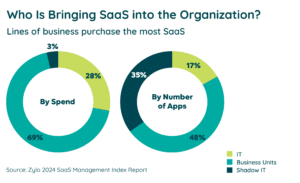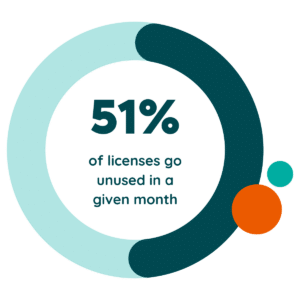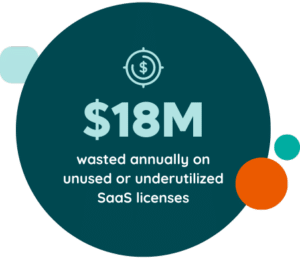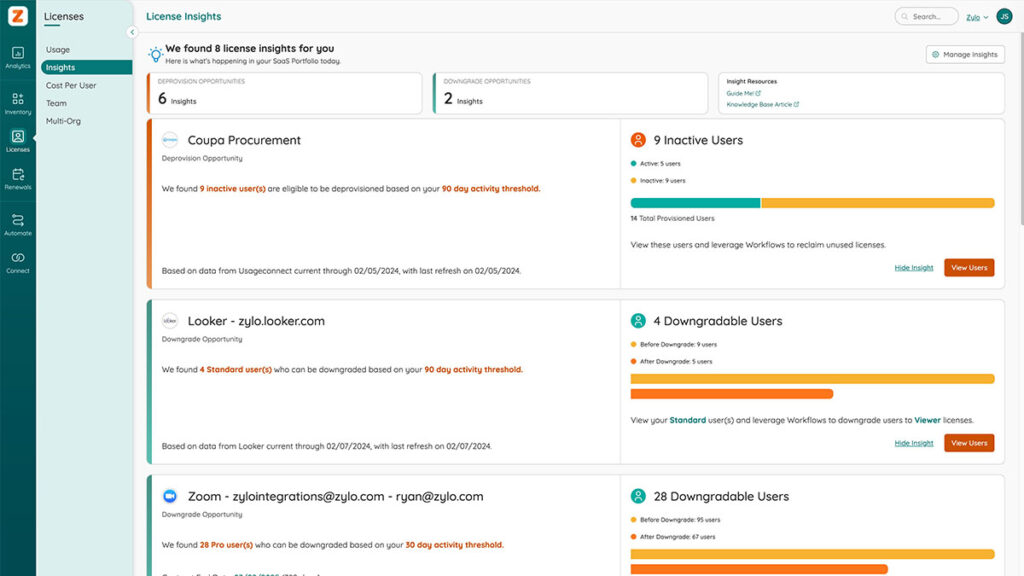Table of Contents
In the age of SaaS, software is purchased as never before – and creates major impacts for SaaS licensing. The subscription model enabled enterprises to maintain agile investments, turning on and off services in a matter of months, rather than years. However, this subscription economy has impacted where this software is bought, as well as how.
Lines of Business (LOBs), business units, functions, or departments are buying and managing software without including nor informing IT.
 In fact, Zylo’s SaaS Management Index reports that more than one-third of all SaaS inventory quantity occurs via employee expense transactions. Often, those purchases live outside the purview of IT and Procurement.
In fact, Zylo’s SaaS Management Index reports that more than one-third of all SaaS inventory quantity occurs via employee expense transactions. Often, those purchases live outside the purview of IT and Procurement.
As LOB leaders are very rarely trained IT managers, SaaS is rampantly mismanaged within an enterprise. As a result, enterprises are experiencing serious consequences, from security breaches to forgotten automatic renewals.
To combat this mismanagement, first and foremost, IT leaders must prioritize the discovery of all applications across the enterprise.
Once you have complete visibility, you can practice more effective software license management. Capturing the utilization data of each application allows IT and Procurement to unlock opportunities for cost containment, risk mitigation, and enterprise-wide value.
In this blog, you will find three key insights through which IT can drive value throughout the software investment (with careful SaaS license measurement and management).
SaaS Software Licenses Are Often Under-Provisioned
According to Zylo data, 51% of software licenses are wasted and unused within the enterprise, highlighting that SaaS buyers’ first mistake is often to buy too many licenses. When buying on-prem software, buying up to 10% more licenses than expected was a way to safeguard against the insurmountable fees following a software audit.
 However, today, over-provisioning licenses is not as detrimental to an organization as under-provisioning. In fact, under the new SaaS licensing buying model, over-provisioning is impossible. Each license is attached to a cloud-based account that guarantees an enterprise can’t provision more licenses than purchased.
However, today, over-provisioning licenses is not as detrimental to an organization as under-provisioning. In fact, under the new SaaS licensing buying model, over-provisioning is impossible. Each license is attached to a cloud-based account that guarantees an enterprise can’t provision more licenses than purchased.
Consequently, today cost containment opportunities are throttled by over-buying and underprovisioning licenses.
PRO TIP: Keep no more than 5% of licenses unprovisioned. You can always buy more licenses from your SaaS vendor, often at an equivalent price per license. However, you can never sell those licenses back to the vendor. In the age of SaaS, plan for less, not more.
Deprovision Inactive Licenses to Contain Costs and Mitigate Risk
Compared to on-premises software, the access to utilization data is an unparalleled feature of cloud-based software in terms of IT planning. With nearly half of all provisioned licenses inactive across the enterprise, organizations have a long way to go in terms of optimizing SaaS utilization and licensing. In fact, the average organization wastes $18M annually as a result of this lack of use.
 To reduce inactive licenses, IT must discover all the inactive licenses throughout the enterprise. With hundreds of inactive licenses across the organization, the process of revoking inactive licenses can quickly become unwieldy. SaaS management platforms offer assistance when identifying and deprovisioning inactive licenses.
To reduce inactive licenses, IT must discover all the inactive licenses throughout the enterprise. With hundreds of inactive licenses across the organization, the process of revoking inactive licenses can quickly become unwieldy. SaaS management platforms offer assistance when identifying and deprovisioning inactive licenses.
To limit the proliferation of inactive licenses, evaluate licensing expectations during software adoption and renewal processes. With the understanding that over a fourth of licenses are inactive, IT and LOBs can uncover many cost containment opportunities by reducing the number of overall licenses purchased.
PRO TIP: To uncover cost containment opportunities and mitigate risk, identify and deprovision inactive licenses on a regular basis. For applications that house sensitive data, be especially steadfast in identifying and revoking inactive licenses.
Additionally, to stop the proliferation of inactive licenses, set processes that accurately forecast the number of licenses necessary during SaaS purchase and renewal.
Focus SaaS Licensing Optimization Efforts on Commonly Underutilized Applications
Nearly 51% of all licenses tracked in Zylo are underutilized. In many cases, the underutilization is caused because applications with overlapping functions compete for use. In other cases, as with in-active licenses, implementation of the application failed or licenses have been unnecessarily provisioned. No matter the reason, enterprises face opportunities for cost containment and risk mitigation by identifying areas of rampant underutilization.
Following Zylo’s anonymized customer data, applications through which to start identifying and deprovisioning licenses are applications with the functions of talent management, customer service, business intelligence, and file storage.

For example, to optimize the SaaS licensing of file sharing and storage applications, identify users who have not uploaded a file to the cloud over a defined period of time, such as a fiscal quarter. Notify the users that their access to upload files to the application may be terminated. Educate the user that storage applications allow even non-users to download files from storage. Then, open the lines for communication to discover next steps.
PRO TIP: As resources are often limited, focus licensing optimization efforts on applications with functions of talent management, customer service, business intelligence, and file storage.
Define a process within your organization to identify underutilized applications, notify users of the underutilization, understand the underutilization, and deprovision the licenses if necessary (alternatively you could build a more effective implementation process or consolidate applications with overlapping functions).
With Zylo, your enterprise-wide utilization data is readily available in one system of record. Now, the enterprise can accurately forecast spend, manage licenses, unlock savings, and mitigate risk. Get a demo today.
The IT Leader’s Guide to Software License Management
Learn More

